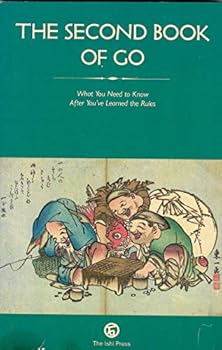The Second Book of Go
(Part of the Beginner and Elementary Go Books Series)
Select Format
Select Condition 
Book Overview
The Second Book Of Go takes the reader who has learned the rules and rudiments of strategy and introduces him or her to the fundamental ideas required to get to the 12 kyu level. This description may be from another edition of this product.
Format:Paperback
Language:English
ISBN:4871870316
ISBN13:9784871870313
Release Date:January 1987
Publisher:Ishi Press International
Length:124 Pages
Weight:0.35 lbs.
Dimensions:0.3" x 5.4" x 8.4"
Customer Reviews
5 ratings
Excellent for a beginner who has mastered the moves
Published by Thriftbooks.com User , 14 years ago
This book is very good for a beginner who understands the basics (territory, keeping connected, etc.) and learns quickly. It is understandable. It covers vital topics, like life and death and tesujis. For someone who really wants to understand Go, it is not a substitute for the other 20 or so indispensable books, like Life and Death (Beginner and Elementary Go Books). If you like very simple, slow introductions to Go strategy and tactics instead, I recommend Learn to Play Go: A Master's Guide to the Ultimate Game (Volume I) (which has about six easy-to-read volumes).
A title that says exactly what it is!
Published by Thriftbooks.com User , 18 years ago
The title says it very accurately. This should be your second book to the game of Go. If you are unfamilar with the game, Go is a beautiful game with the depth of chess, but the openings are a little more abstract than chess. Chess players usually love Go and Go players usually love chess. This however is one of the best primers to a complex strategy game that I've ever seen. If you are brand new to the game, I recommend starting off with "The Magic of Go" and follow it with this book. Both books are just the right size. I find introductory books that are 200 or 300 pages long tend to be good reference books, but are not as easy to learn from. These two books are shorter books that are easy to sit down with, absorb, and complete. After these two books, come a wide range of other excellent books (I find that the quality of Go books that have been translated into English is very high.) I rate "The Magic of Go" and "The Second book of Go" as absolute must haves if you are going to learn more about this wonderful game.
Filling the gap none others due.
Published by Thriftbooks.com User , 22 years ago
I almost never give a book 5 stars, and probably wouldn't have here if it weren't for the fact that the book is practically the only of its kind in my experience. I would estimate it is best for the 14-20 kyu (American), but one can stretch that by 4 in either direction.I would say this books greatest strengths are its breadth and its focus on principles and explanation.
A worthwhile read
Published by Thriftbooks.com User , 26 years ago
As the title suggests, this book would be good as a second book in your go study. I tried part of the Elementary Go series after my first book (Iwamoto's), got a bit frustrated, and then went back and read this - and I'm glad I did finally get around to reading this book. I'll probably go back to the Elementary Go series after I finish Lessons in the Fundamentals of Go next.The chapters on capturing races were very good; these alone are worth the price of the book. I usually avoid rote memorization (EG, I find joseki study boring), but the six types of capturing races seemed quite worth committing to memory, so I did.(nearly?) every chapter has recommendations on books to read for further study of the subject covered by that chapter.If you're serious about go, I'd recommend something else as a first book (of course), but it'd be a good idea to make this your second - read concurrently with the first two volumes of Kano's "Graded Go Problems for Beginners".
A must have if you want to learn the game of Go.
Published by Thriftbooks.com User , 27 years ago
The rules of Go can be explained in less than 10 minutes. This book takes you to the next step after to rules to the basic mechanics, concepts, and features of the game; how Go "works".





